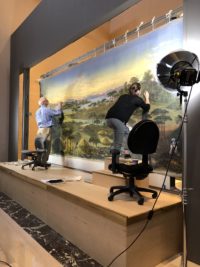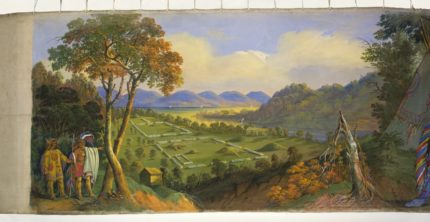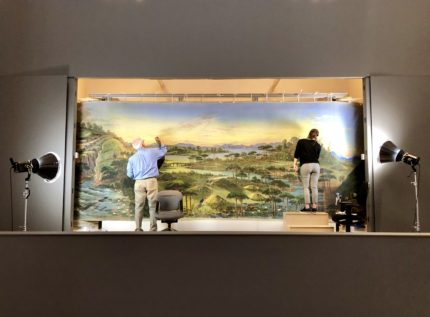Saint Louis Art Museum conservators are restoring Panorama of the Monumental Grandeur of the Mississippi Valley in public view for museum visitors. The massive scroll of painted fabric is being unrolled sections at a time in the southwest corner of Sculpture Hall so that conservators can repair it while museum visitors look on and ask questions.
It is 7.5 feet high and 348 feet long, an example of the hugely fashionable trend for massive panoramas that were installed in custom-built rotundas or played in temporary venues. Painted in vivid colors and displayed with spotlights and live music, the panorama would scroll through 25 distinct scenes before a viewing audience. An advertisement for one of these shows in Pennsylvania in 1851 announces in a bewildering proliferation of fonts that erudite lectures on the “ANQUITIES & CUSTOMS OF THE UNHISTORIED INDIAN TRIBES” will accompany the unfurling of the panorama “with all the aboriginal monuments of a large extent of the Country” covering more than 15,000 feet of canvas. It was so huge and so difficult to roll that the morning show would feature the trip down the Mississippi, and then afternoon would just run it backwards, narrating a trip up the river.
What is truly extraordinary about this piece is how thoroughly it covers archaeological discoveries, depicting the excavation of ancient mounds and dinosaur fossils. It shows the digging being done by black slaves, under the command of two white men, an accurate capture of how these mounds were sectioned in the mid-19th century. Other Native American archaeological sites dot the vast Mississippi Valley landscape.
The reason for this unusually specific viewpoint for a panorama is that the work was commissioned by physician and natural scientist Montroville Wilson Dickeson who, by his own account excavated more than 1,000 mounds from which he recovered more than 40,000 artifacts. His field drawings became the basis of the archaeology scenes in the panorama. Dickeson hired artist John J. Egan to create a compelling backdrop for his lectures whose exhibition would help fund further excavations.
Five panoramas of the Mississippi were made in the 1840s. Their great size and detailed depictions of the “Father of Waters” made them a hit with audiences, perhaps too much of a hit as none of them have survived. Egan’s later work is the only one of the trend to be extant. It too is endangered by its years of hard work. It was painted in distemper on cotton muslin and over time all the dismounting, mounting, scrolling and traveling damaged the textile and the paint.
 When the museum acquired it in 1953, it was in bad condition. An ambitious program of restoration began in 2011. The old wooden rollers were replaced by metal drums and a motorized rolling system. Paint loss and damage to the muslin has been repaired on individual panels. Now the end of the long voyage down the Mississippi River is in sight, with only three remaining panels in the process of treatment.
When the museum acquired it in 1953, it was in bad condition. An ambitious program of restoration began in 2011. The old wooden rollers were replaced by metal drums and a motorized rolling system. Paint loss and damage to the muslin has been repaired on individual panels. Now the end of the long voyage down the Mississippi River is in sight, with only three remaining panels in the process of treatment.
Conservators will complete the extensive, nine-year project by treating and preserving the final three damaged scenes. During this process, Museum visitors have the unique opportunity to observe and interact with the conservation team while they work. In addition, Museum docents, curators, and conservators will provide additional insights to visitors on scheduled weekdays in Sculpture Hall.



given the hilliness of the country along the river in the scenes shown it seems questionable whether the artist had actually seen the Mississippi Valley. There are places where there are bluffs along the river such as Wisconsin and the Vicksburg area of Mississippi but for the most part it is a wide, flat flood plain extending back from the river. A well, artistic license covers a multitude of sins.
Fascinating article, excellent graphics. Here’s a couple of stories about the fate of two American “cycloramas” you might enjoy.
https://www.ajc.com/entertainment/restored-cyclorama-opens/p0q5kiMQtS08OJjvjiRzgK/